初一年级保护动物英文电子小报修改稿
保护动物英语小报初中
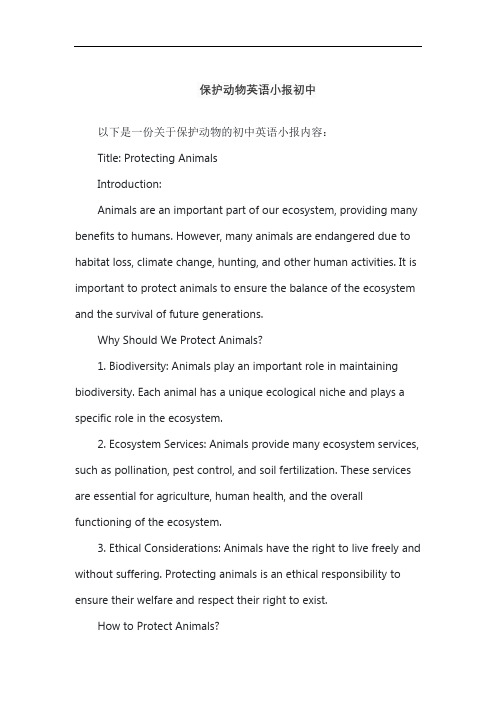
保护动物英语小报初中以下是一份关于保护动物的初中英语小报内容:Title: Protecting AnimalsIntroduction:Animals are an important part of our ecosystem, providing many benefits to humans. However, many animals are endangered due to habitat loss, climate change, hunting, and other human activities. It is important to protect animals to ensure the balance of the ecosystem and the survival of future generations.Why Should We Protect Animals?1. Biodiversity: Animals play an important role in maintaining biodiversity. Each animal has a unique ecological niche and plays a specific role in the ecosystem.2. Ecosystem Services: Animals provide many ecosystem services, such as pollination, pest control, and soil fertilization. These services are essential for agriculture, human health, and the overall functioning of the ecosystem.3. Ethical Considerations: Animals have the right to live freely and without suffering. Protecting animals is an ethical responsibility to ensure their welfare and respect their right to exist.How to Protect Animals?1. Conservation of Habitats: Protecting the natural habitats of animals is crucial. This includes preserving forests, wetlands, and other ecosystems to provide a suitable environment for animals to thrive.2. Wildlife Conservation Laws: Governments should enact and enforce strict wildlife conservation laws to prevent illegal hunting, trading, and habitat destruction.3. Education and Awareness: Raising awareness about the importance of animal protection is essential. Education programs can help people understand the impact of human activities on animals and encourage them to take action.4. Support Conservation Organizations: Donating to conservation organizations or participating in their conservation efforts can make a significant difference in protecting animals and their habitats.Conclusion:Protecting animals is crucial for the survival of the ecosystem and the well-being of future generations. By conserving their habitats, enacting wildlife conservation laws, raising awareness, and supporting conservation organizations, we can ensure the coexistence of humans and animals on our planet. Let's work together to protect and preserve the rich diversity of animal life.。
英语关于介绍保护动物小报
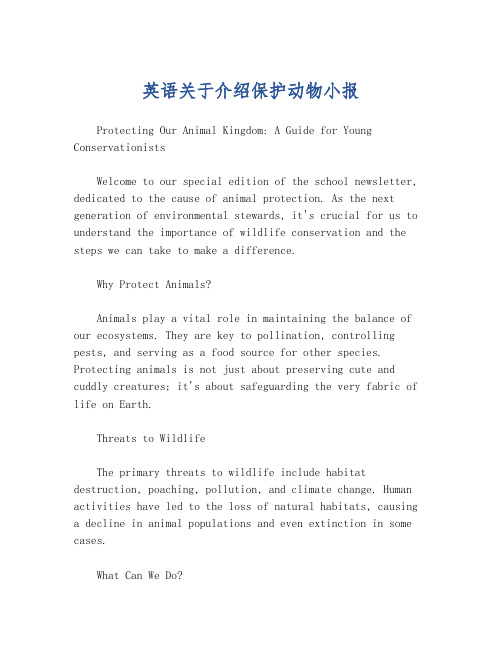
英语关于介绍保护动物小报Protecting Our Animal Kingdom: A Guide for Young ConservationistsWelcome to our special edition of the school newsletter, dedicated to the cause of animal protection. As the next generation of environmental stewards, it's crucial for us to understand the importance of wildlife conservation and the steps we can take to make a difference.Why Protect Animals?Animals play a vital role in maintaining the balance of our ecosystems. They are key to pollination, controlling pests, and serving as a food source for other species. Protecting animals is not just about preserving cute and cuddly creatures; it's about safeguarding the very fabric of life on Earth.Threats to WildlifeThe primary threats to wildlife include habitat destruction, poaching, pollution, and climate change. Human activities have led to the loss of natural habitats, causing a decline in animal populations and even extinction in some cases.What Can We Do?1. Educate Ourselves and Others: Learn about the species that share our planet and the challenges they face. Sharethis knowledge with your friends and family.2. Support Conservation Efforts: Donate to or volunteer with organizations that work to protect animals and their habitats.3. Reduce, Reuse, Recycle: Cutting down on waste helps reduce pollution and the need for new landfills, which can encroach on wildlife habitats.4. Go Green: Support renewable energy and sustainable practices to combat climate change, a significant threat to many animal species.5. Speak Up: Advocate for stronger laws and policies that protect animals and their habitats.Get Involved- Join a local wildlife conservation group or start onein your school.- Participate in beach clean-ups or tree planting events.- Create a wildlife-friendly garden by planting native species that provide food and shelter for local wildlife.Success Stories1. The Giant Panda: Once endangered, the panda'spopulation has rebounded thanks to conservation efforts and habitat protection.2. The Bald Eagle: This symbol of the United States was removed from the endangered species list due to protective legislation and habitat restoration.In ConclusionEvery action counts, no matter how small. By working together, we can ensure a future where all species can thrive. Remember, the world is not just our home—it's the home of countless other creatures, and we share the responsibility to protect it.Upcoming Events- Wildlife Conservation Workshop: Date TBD, in the school auditorium.- Animal Protection Film Screening: Date TBD, featuring documentaries on endangered species.Let's join hands to protect our animal kingdom for the generations to come. Together, we can make a difference!Contact InformationFor more information on how you can get involved, contact:- [Name of Conservation Club or Teacher]- Email: [Email Address]- Phone: [Phone Number]Don't forget to check out our website for more resources and updates on conservation efforts.Protecting Wildlife, Preserving Our Planet.。
英语作文保护动物范文初一
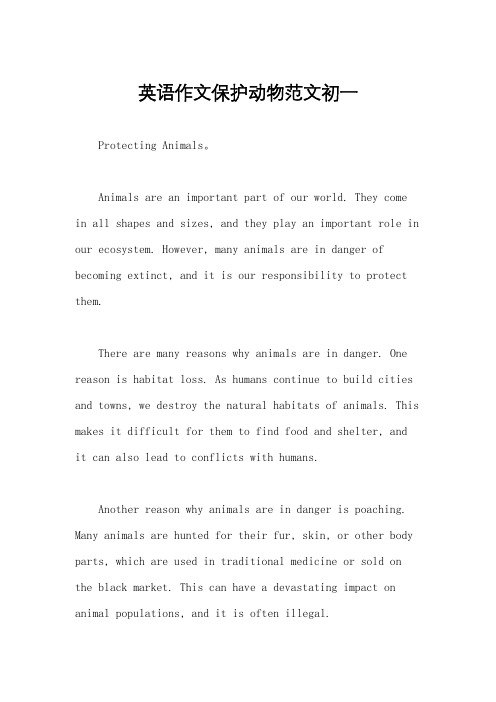
英语作文保护动物范文初一Protecting Animals。
Animals are an important part of our world. They come in all shapes and sizes, and they play an important role in our ecosystem. However, many animals are in danger of becoming extinct, and it is our responsibility to protect them.There are many reasons why animals are in danger. One reason is habitat loss. As humans continue to build cities and towns, we destroy the natural habitats of animals. This makes it difficult for them to find food and shelter, and it can also lead to conflicts with humans.Another reason why animals are in danger is poaching. Many animals are hunted for their fur, skin, or other body parts, which are used in traditional medicine or sold on the black market. This can have a devastating impact on animal populations, and it is often illegal.To protect animals, we need to take action. One way to do this is to support conservation efforts. Many organizations work to protect endangered species and their habitats, and they rely on donations and volunteers to do their work.Another way to protect animals is to reduce our impact on the environment. We can do this by using renewable energy sources, reducing our use of single-use plastics, and supporting sustainable agriculture practices.Finally, we can protect animals by educating others about the importance of conservation. By raising awareness about the threats facing animals, we can inspire others to take action and make a difference.In conclusion, protecting animals is an important responsibility that we all share. By supporting conservation efforts, reducing our impact on the environment, and educating others, we can help ensure that animals continue to thrive in our world.。
英语保护动物手抄报内容
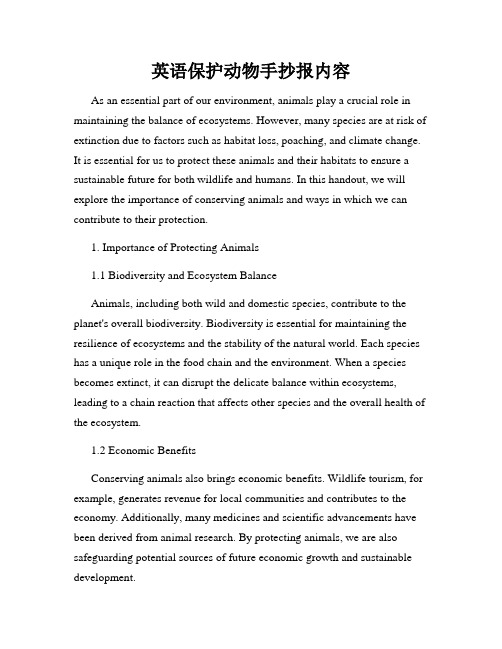
英语保护动物手抄报内容As an essential part of our environment, animals play a crucial role in maintaining the balance of ecosystems. However, many species are at risk of extinction due to factors such as habitat loss, poaching, and climate change. It is essential for us to protect these animals and their habitats to ensure a sustainable future for both wildlife and humans. In this handout, we will explore the importance of conserving animals and ways in which we can contribute to their protection.1. Importance of Protecting Animals1.1 Biodiversity and Ecosystem BalanceAnimals, including both wild and domestic species, contribute to the planet's overall biodiversity. Biodiversity is essential for maintaining the resilience of ecosystems and the stability of the natural world. Each species has a unique role in the food chain and the environment. When a species becomes extinct, it can disrupt the delicate balance within ecosystems, leading to a chain reaction that affects other species and the overall health of the ecosystem.1.2 Economic BenefitsConserving animals also brings economic benefits. Wildlife tourism, for example, generates revenue for local communities and contributes to the economy. Additionally, many medicines and scientific advancements have been derived from animal research. By protecting animals, we are also safeguarding potential sources of future economic growth and sustainable development.2. Threats to Animal Conservation2.1 Habitat LossOne of the primary threats to animal conservation is habitat loss. Deforestation, urbanization, and the conversion of natural habitats for agriculture or industrial purposes have a devastating impact on wildlife. Many animals lose their homes, food sources, and breeding grounds, pushing them towards extinction.2.2 Poaching and Illegal Wildlife TradePoaching and illegal wildlife trade pose significant threats to many animal species. The demand for animal products, such as ivory, rhino horns, and exotic pets, drives these illegal activities. Poaching not only diminishes animal populations but also disrupts ecosystems and threatens local communities that depend on wildlife for their livelihoods.2.3 Climate ChangeClimate change is another critical factor impacting animal conservation. Rising temperatures, changing rainfall patterns, and extreme weather events can lead to habitat degradation and the loss of critical resources for animals. Furthermore, climate change alters ecosystems, making it difficult for some species to adapt and survive.3. Conservation Efforts3.1 Protected Areas and National ParksDesignating protected areas and national parks is a crucial step in preserving animal habitats. These areas provide safe havens for wildlife andenable the enforcement of laws against poaching and illegal activities. They also serve as educational and research centers, raising awareness about the importance of animal conservation.3.2 Sustainable Land UsePromoting sustainable land use practices can help mitigate habitat loss. This includes responsible farming methods, reforestation initiatives, and land-use planning that takes into account the needs of both humans and wildlife. By protecting and restoring natural habitats, we can provide suitable environments for animals to thrive.3.3 Education and AwarenessEducating the public about the importance of animal conservation is essential for long-term change. Outreach programs, campaigns, and educational initiatives can raise awareness and inspire individuals to take action. By understanding the interconnectedness of all species and the impact of our actions, we can make informed choices to protect animals and their habitats.4. Individual Actions4.1 Support Conservation OrganizationsContributing to reputable conservation organizations can make a significant difference. These organizations work on the ground to protect animals, promote sustainable practices, and advocate for policy changes. By supporting them financially or through volunteer work, individuals can actively contribute to animal conservation efforts.4.2 Responsible ConsumptionBeing mindful of our consumption choices can have a positive impact on animal conservation. Avoiding products derived from endangered animals, choosing sustainably sourced food, and opting for cruelty-free products are examples of responsible consumption practices that contribute to wildlife protection.4.3 Engage in Sustainable TourismWhen traveling, choose eco-friendly tour operators and visit animal sanctuaries that prioritize animal welfare. Avoid supporting activities that involve captive or exploited animals. Responsible tourism practices can promote sustainable economic opportunities for local communities while safeguarding animals and their habitats.In conclusion, the conservation of animals is of utmost importance to preserve biodiversity, maintain ecosystem balance, and secure our own future. By understanding the significance of protecting animals and taking individual and collective actions, we can make a positive impact on their survival. Let us work together to ensure a world where both humans and animals can thrive harmoniously.。
关于保护动物的手抄报内容,英文版

关于保护动物的手抄报内容,英文版Title: Safeguarding Our Precious Animal Kingdom.In the vast and diverse ecosystem of our planet, animals play a crucial role in maintaining the balance of nature. They are an integral part of our environment, contributing to the health and well-being of our planet. However, due to human activities such as deforestation, pollution, and climate change, animals are facing unprecedented threats to their survival. It is our responsibility to safeguard these innocent creatures and ensure their well-being for future generations.One of the primary reasons for the decline in animal populations is the loss of their natural habitats. As human beings, we have encroached upon their territories for agricultural expansion, urbanization, and other developmental activities. This has led to the displacement and death of many animals, pushing them towards extinction. To mitigate this, we must take measures to conserve andrestore their habitats. We can plant more trees, reduce deforestation, and create protected areas where animals can thrive safely.Another significant threat to animals is poaching and illegal trade. Many endangered species are targeted fortheir body parts, such as fur, ivory, and rhino horns,which are sold for high prices in the illegal wildlife trade. This trade not only decimates animal populations but also funds criminal activities such as terrorism and organized crime. To combat this menace, we must enforcestrict laws against poaching and trafficking, and ensurethat the perpetrators are brought to justice.Climate change is another major concern for animals. Rising temperatures, melting ice caps, and extreme weather events are disrupting their habitats and food sources. This is affecting their survival and reproduction rates, leading to population declines. To address this issue, we must reduce our carbon emissions, adopt renewable energy sources, and take measures to mitigate the impact of climate change.In addition to these measures, we can also contribute to animal conservation by adopting eco-friendly practices in our daily lives. For example, we can reduce our consumption of meat, which has a significant impact on the environment and animal welfare. We can also support organizations that are working to protect animals and their habitats by volunteering, donating, or spreading awareness through social media and other platforms.Moreover, education is crucial in fostering a culture of respect and compassion towards animals. We must instill in our children the importance of protecting animals and the environment. By doing so, we can create a generation that values sustainability, conservation, and coexistence with all living beings.In conclusion, safeguarding animals is not just an environmental imperative; it is a moral obligation. The well-being of animals is intricately linked to our own survival and prosperity. By taking actions to conservetheir habitats, combat poaching, mitigate climate change, and adopting eco-friendly practices, we can ensure aharmonious and sustainable future for all living beings on this planet. Let us come together and safeguard our precious animal kingdom for generations to come.。
保护野生动物英文手抄报模板
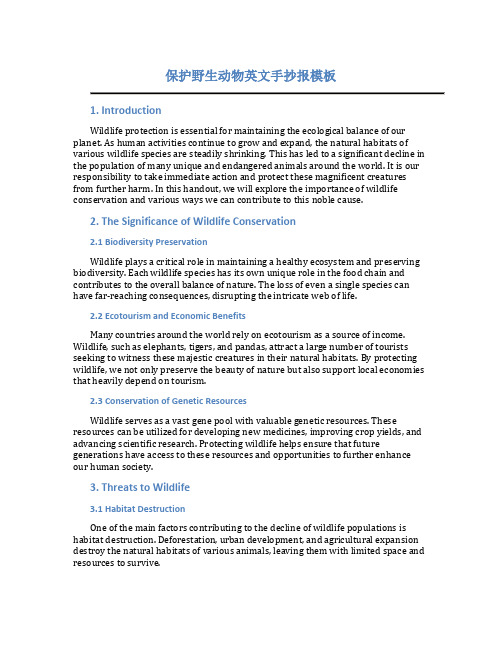
保护野生动物英文手抄报模板1. IntroductionWildlife protection is essential for maintaining the ecological balance of our planet. As human activities continue to grow and expand, the natural habitats of various wildlife species are steadily shrinking. This has led to a significant decline in the population of many unique and endangered animals around the world. It is our responsibility to take immediate action and protect these magnificent creatures from further harm. In this handout, we will explore the importance of wildlife conservation and various ways we can contribute to this noble cause.2. The Significance of Wildlife Conservation2.1 Biodiversity PreservationWildlife plays a critical role in maintaining a healthy ecosystem and preserving biodiversity. Each wildlife species has its own unique role in the food chain and contributes to the overall balance of nature. The loss of even a single species can have far-reaching consequences, disrupting the intricate web of life.2.2 Ecotourism and Economic BenefitsMany countries around the world rely on ecotourism as a source of income. Wildlife, such as elephants, tigers, and pandas, attract a large number of tourists seeking to witness these majestic creatures in their natural habitats. By protecting wildlife, we not only preserve the beauty of nature but also support local economies that heavily depend on tourism.2.3 Conservation of Genetic ResourcesWildlife serves as a vast gene pool with valuable genetic resources. These resources can be utilized for developing new medicines, improving crop yields, and advancing scientific research. Protecting wildlife helps ensure that future generations have access to these resources and opportunities to further enhance our human society.3. Threats to Wildlife3.1 Habitat DestructionOne of the main factors contributing to the decline of wildlife populations is habitat destruction. Deforestation, urban development, and agricultural expansion destroy the natural habitats of various animals, leaving them with limited space and resources to survive.3.2 Human-Wildlife ConflictAs human settlements expand into previously undisturbed areas, conflicts between humans and wildlife increase. Animals may raid crops or livestock, resulting in retaliatory actions. It is important to find the balance between human development and wildlife conservation to minimize these conflicts.3.3 Illegal Wildlife TradeIllegal wildlife trade is a multi-billion dollar industry that poses a significant threat to endangered species. Animals are captured or killed for their parts and products, such as ivory, skins, and bones. Strict laws and regulations, along with international cooperation, are necessary to combat this illegal trade.4. Ways to Protect Wildlife4.1 Protecting Natural HabitatsPreserving natural habitats is crucial for wildlife conservation. Efforts should be made to establish protected areas, such as national parks and wildlife reserves, where animals can thrive undisturbed. Restoration projects can also help reclaim and rehabilitate damaged ecosystems.4.2 Promoting Sustainable PracticesSustainable practices, such as responsible tourism, organic farming, and renewable energy, help minimize the negative impact on wildlife and their habitats. By adopting these practices, we can ensure the long-term survival of both human and animal populations.4.3 Spreading Awareness and EducationRaising awareness about the importance of wildlife conservation is key to mobilizing support and action. Education programs, workshops, and campaigns can help people understand the value of biodiversity and the role they can play in protecting it. Schools, community centers, and social media platforms are great channels for spreading this message.5. ConclusionThe protection of wildlife is not only a moral obligation but also crucial for maintaining the health and balance of our planet. By recognizing the significance of wildlife conservation, understanding the threats they face, and taking action to protect them, we can ensure the survival of diverse species for generations to come.Let us all join hands and work towards a future where humans and wildlife coexist harmoniously, benefiting from the beauty and resources our planet has to offer.Note: This document is a sample handout/template and serves as a starting point for creating your own handout about wildlife conservation. Feel free to add more information, specific examples, or personal experiences to make it more engaging and informative.。
关于保护动物的英语作文七年级
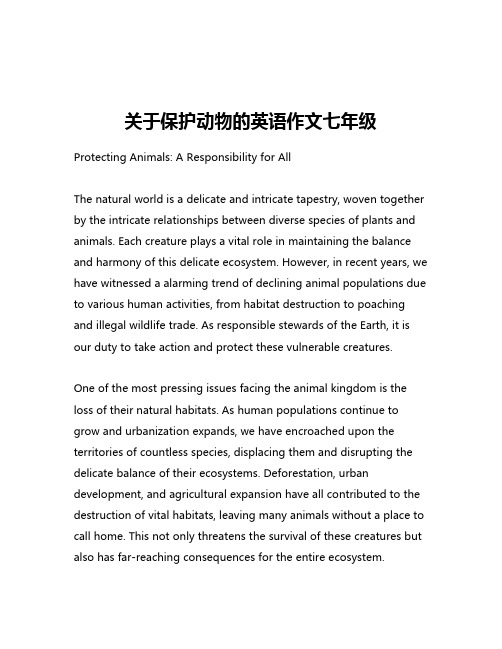
关于保护动物的英语作文七年级Protecting Animals: A Responsibility for AllThe natural world is a delicate and intricate tapestry, woven together by the intricate relationships between diverse species of plants and animals. Each creature plays a vital role in maintaining the balance and harmony of this delicate ecosystem. However, in recent years, we have witnessed a alarming trend of declining animal populations due to various human activities, from habitat destruction to poaching and illegal wildlife trade. As responsible stewards of the Earth, it is our duty to take action and protect these vulnerable creatures.One of the most pressing issues facing the animal kingdom is the loss of their natural habitats. As human populations continue to grow and urbanization expands, we have encroached upon the territories of countless species, displacing them and disrupting the delicate balance of their ecosystems. Deforestation, urban development, and agricultural expansion have all contributed to the destruction of vital habitats, leaving many animals without a place to call home. This not only threatens the survival of these creatures but also has far-reaching consequences for the entire ecosystem.In addition to habitat loss, the illegal wildlife trade poses a significant threat to many animal species. Driven by the demand for exotic pets, traditional medicine, and luxury goods, poachers and wildlife traffickers have decimated populations of endangered animals, such as elephants, rhinos, and tigers. These activities not only deplete the natural populations but also contribute to the suffering and exploitation of these sentient beings. It is our responsibility to crack down on this illicit trade and enforce strict regulations to protect these vulnerable species.Another pressing concern is the impact of human-caused climate change on the animal kingdom. As global temperatures rise and weather patterns become increasingly unpredictable, many species are struggling to adapt to these rapidly changing conditions. Polar bears, for example, are facing the loss of their sea ice habitats, while coral reefs are being devastated by ocean acidification and warming waters. These environmental changes can disrupt the delicate balance of ecosystems, leading to the decline and extinction of countless species.Fortunately, there are numerous ways in which we can take action to protect the animals we share our planet with. One of the most important steps is to support and participate in conservation efforts. This can involve volunteering with local wildlife organizations, donating to reputable conservation charities, or even adopting anendangered animal through a sponsorship program. By actively contributing to these efforts, we can help to fund critical research, habitat restoration, and anti-poaching initiatives.Additionally, we can make conscious choices in our daily lives to reduce our impact on the environment and support sustainable practices. This can include reducing our consumption of resources, recycling and reducing waste, and choosing eco-friendly products and services. By making small changes in our individual behaviors, we can collectively make a significant difference in the lives of animals around the world.Education and awareness are also crucial in the fight to protect animals. By teaching children and young adults about the importance of biodiversity and the threats facing various species, we can instill a sense of responsibility and stewardship in the next generation. This can involve incorporating environmental education into school curriculums, supporting educational programs at zoos and wildlife centers, and encouraging families to explore and appreciate the natural world.Furthermore, we must advocate for stronger policies and regulations to safeguard the rights and welfare of animals. This can involve contacting local and national government representatives to voice our concerns, supporting legislation that protects endangeredspecies and their habitats, and pressuring corporations to adopt more ethical and sustainable practices.In conclusion, the protection of animals is a responsibility that falls upon all of us. By working together to address the various threats facing the animal kingdom, we can ensure the preservation of our planet's rich biodiversity and the continued well-being of the creatures we share this world with. Through our collective actions, we can make a lasting impact and leave a legacy of a healthier, more vibrant natural world for generations to come.。
保护动物英语范文初一
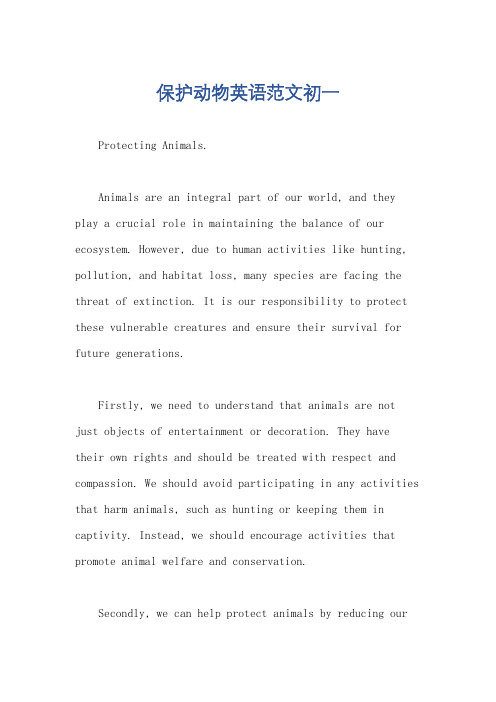
保护动物英语范文初一Protecting Animals.Animals are an integral part of our world, and they play a crucial role in maintaining the balance of our ecosystem. However, due to human activities like hunting, pollution, and habitat loss, many species are facing the threat of extinction. It is our responsibility to protect these vulnerable creatures and ensure their survival for future generations.Firstly, we need to understand that animals are notjust objects of entertainment or decoration. They havetheir own rights and should be treated with respect and compassion. We should avoid participating in any activities that harm animals, such as hunting or keeping them in captivity. Instead, we should encourage activities that promote animal welfare and conservation.Secondly, we can help protect animals by reducing ourcarbon footprint and minimizing pollution. Climate changeis a major threat to animals, as it disrupts their habitats and food sources. By reducing our use of fossil fuels and recycling, we can help mitigate the effects of climate change and provide a safer environment for animals.Thirdly, we can support organizations that are working to protect endangered species. These organizations often carry out research, monitor animal populations, and create awareness about the need for conservation. By volunteering or donating to these organizations, we can make adifference in the lives of animals.Fourthly, we can educate ourselves and others about the importance of animal protection. Knowledge is power, and by educating ourselves, we can make informed decisions that benefit animals. We can also spread awareness among our friends and family, encouraging them to adopt a more compassionate and responsible attitude towards animals.In conclusion, protecting animals is crucial for the health and diversity of our planet. It is ourresponsibility to ensure that future generations can enjoy the beauty and wonder of animals. By adopting a compassionate and responsible attitude towards animals, we can create a safer and more harmonious world for all living beings.Moreover, protecting animals is not just about saving individual species from extinction. It is about maintaining the delicate balance of our ecosystem, which in turnaffects our own lives. Animals play crucial roles in pollination, seed dispersal, nutrient cycling, and pest control, among other essential functions. By protecting animals, we are also protecting the health and productivity of our own environment.Additionally, animals contribute significantly to our cultural and spiritual heritage. They have been a part of human history and civilization for thousands of years, and they continue to inspire us with their beauty, intelligence, and resilience. By protecting animals, we are also preserving our own cultural identity and spiritual values.In order to effectively protect animals, we need to adopt a holistic approach that addresses the root causes of their decline. This includes addressing issues like deforestation, poaching, and climate change, which are often the result of human activities. We also need to promote sustainable living practices that reduce our impact on the environment and provide safe habitats for animals.Finally, we need to remember that protecting animals is not just about saving them from extinction. It is about treating them with respect and dignity, and recognizing their inherent value as living beings. By doing so, we can create a more compassionate and inclusive society that values all forms of life.In conclusion, protecting animals is a crucial responsibility that we all share. It involves understanding their importance, reducing our impact on the environment, supporting conservation efforts, and promoting awareness and education. By taking these actions, we can ensure that animals are protected for future generations and contribute to a healthier, more harmonious world.。
关于保护动物的小报英语

关于保护动物的小报英语Animal Protection: Our Responsibility and DutyIn today's world, animals are facing numerous threats that are endangering their survival. As a society, it is our responsibility to ensure that these innocent creatures are protected and treated with the respect they deserve.Firstly, it is important to recognize that animals are essential components of our ecosystem. They play vital roles in maintaining the balance of nature and providing essential services such as pollination and controlling pest populations. Therefore, protecting animals is crucial for safeguarding our environment.Secondly, animals are sentient beings who experience pain, fear, and joy just as we do. It is unethical to inflict harm or suffering on them, and we have a duty to provide them with safe habitats and sufficient resources to thrive.In order to effectively protect animals, it is necessary to take several measures. Firstly, we need to promote awareness about animal protection. Educating the public about the importance of animals in our ecosystems and the need to respect their rights can help foster a culture of compassion towards animals.Secondly, we need to enforce laws that protect animals from abuse and exploitation. Legislation should be put in place to ensure thatanimals are treated humanely and that those who violate animal rights are held accountable.Moreover, we need to encourage sustainable practices that benefit both animals and humans. For instance, we can support animal-friendly farming methods that minimize animal suffering and promote environmental sustainability. We can also encourage the adoption of pets from shelters instead of purchasing from breeders or pet stores.Finally, we can all make a difference by taking individual actions to help animals in our daily lives. We can become vegans or vegetarians to reduce animal suffering, adopt homeless animals, or simply be more mindful of our impact on animals around us.In conclusion, protecting animals is not only about safeguarding their survival but also about upholding our moral and ethical responsibilities towards them. Let us come together and do our part to ensure that animals are treated with the respect and kindness they deserve.。
关于保护野生动物的英语手抄报
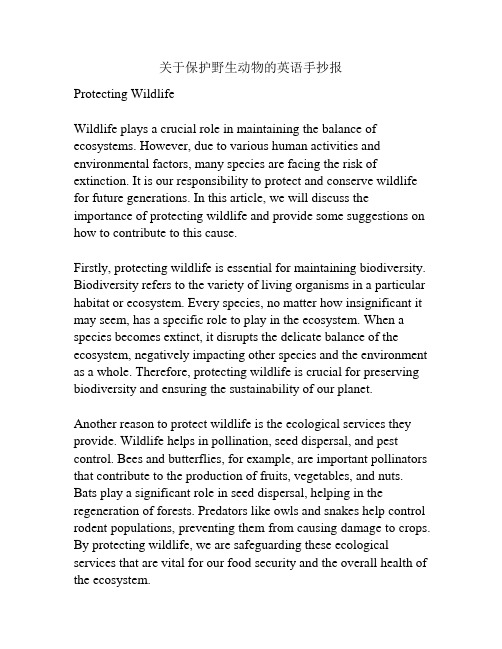
关于保护野生动物的英语手抄报Protecting WildlifeWildlife plays a crucial role in maintaining the balance of ecosystems. However, due to various human activities and environmental factors, many species are facing the risk of extinction. It is our responsibility to protect and conserve wildlife for future generations. In this article, we will discuss the importance of protecting wildlife and provide some suggestions on how to contribute to this cause.Firstly, protecting wildlife is essential for maintaining biodiversity. Biodiversity refers to the variety of living organisms in a particular habitat or ecosystem. Every species, no matter how insignificant it may seem, has a specific role to play in the ecosystem. When a species becomes extinct, it disrupts the delicate balance of the ecosystem, negatively impacting other species and the environment as a whole. Therefore, protecting wildlife is crucial for preserving biodiversity and ensuring the sustainability of our planet.Another reason to protect wildlife is the ecological services they provide. Wildlife helps in pollination, seed dispersal, and pest control. Bees and butterflies, for example, are important pollinators that contribute to the production of fruits, vegetables, and nuts. Bats play a significant role in seed dispersal, helping in the regeneration of forests. Predators like owls and snakes help control rodent populations, preventing them from causing damage to crops. By protecting wildlife, we are safeguarding these ecological services that are vital for our food security and the overall health of the ecosystem.Moreover, wildlife tourism contributes to local economies and supports conservation efforts. Many countries have established national parks and wildlife reserves to protect endangered species. Visitors to these areas provide financial resources through entrance fees and contribute to the local economy by staying in nearby hotels and purchasing goods and services. This revenue can then be used for conservation projects, habitat restoration, and anti-poaching measures. By supporting responsible wildlife tourism, we can contribute to conservation efforts and provide local communities with incentives to protect wildlife habitats.To actively participate in protecting wildlife, there are several actions we can take. Firstly, we should educate ourselves and raise awareness about the importance of wildlife conservation. By understanding the threats facing wildlife, the role they play in ecosystems, and the need for their protection, we can inspire others to take action. Additionally, we can support organizations dedicated to wildlife conservation by volunteering, donating, or participating in their programs.Another way to protect wildlife is by promoting sustainable practices in our daily lives. For example, we can choose to consume sustainably sourced products, such as timber and seafood, which have been harvested responsibly and do not harm wildlife habitats. We can also reduce our carbon footprint by using public transportation, conserving energy, and adopting eco-friendly habits, thereby mitigating climate change and its impacts on wildlife. Lastly, we should advocate for stronger laws and regulations toprotect wildlife and penalize illegal activities such as poaching and wildlife trafficking. By supporting stricter enforcement of these laws, we can deter criminals and help ensure the survival of endangered species.In conclusion, protecting wildlife is of utmost importance for maintaining biodiversity, preserving ecological services, and supporting local economies. Through education, sustainable practices, and advocacy, we can all contribute to the conservation of wildlife and play a role in securing a better future for our planet and its magnificent creatures. Let us act now to protect wildlife before it's too late.。
保护动物海报英文作文初一

保护动物海报英文作文初一英文回答:Protecting animals is paramount to maintaining a healthy and balanced ecosystem. Animals play a vital rolein the food chain, regulating populations, pollinating plants, and providing essential resources such as food, clothing, and medicine. They also enrich our lives through companionship and aesthetic beauty. However, humanactivities pose significant threats to animal populations, including habitat destruction, pollution, illegal wildlife trade, and climate change.To effectively protect animals, we must adopt a comprehensive and multifaceted approach. This includes:Protecting habitats: Conservation efforts should focus on safeguarding natural habitats, establishing protected areas, and restoring degraded ecosystems.Combating pollution: Reducing emissions from vehicles, industries, and agriculture can mitigate the negative impacts of pollution on wildlife.Enforcing wildlife laws: Governments must implement and enforce strict laws to combat illegal wildlife trade, poaching, and wildlife trafficking.Raising awareness: Public education and outreach campaigns can raise awareness about the importance of animal protection and foster a sense of stewardship.Supporting animal welfare: Initiatives to promote animal welfare in agriculture, research, and transportation can reduce suffering and improve the well-being of animals.Addressing climate change: Mitigating the effects of climate change is crucial for protecting animal species threatened by rising temperatures, habitat loss, and extreme weather events.中文回答:保护动物对于维护一个健康且平衡的生态系统至关重要。
保护动物海报英文作文初一

保护动物海报英文作文初一英文回答:Protect Animals: A Poster Campaign for Wildlife Conservation.Animals are an essential part of our ecosystem, playing crucial roles in maintaining biodiversity, supporting the food chain, and providing us with resources and companionship. However, many animal species are facing threats from habitat loss, poaching, climate change, and other human activities.To raise awareness about the importance of protecting animals, this poster campaign aims to educate people about the threats facing wildlife and inspire them to take action. The posters feature compelling images and thought-provoking slogans that highlight the urgency of animal conservation.By spreading the message of animal protection, thiscampaign hopes to foster a greater appreciation for the beauty and diversity of wildlife. It encourages individuals to make responsible choices that minimize their impact on animals, such as reducing their consumption of animal products, supporting ethical businesses, and advocating for animal welfare laws.The campaign also emphasizes the interconnectedness of all life on Earth.Protecting animals is not only about preserving individual species but also about safeguarding the health of our planet and the future of all living beings.中文回答:保护动物,野生动物保护海报活动。
关于保护动物的英语小报
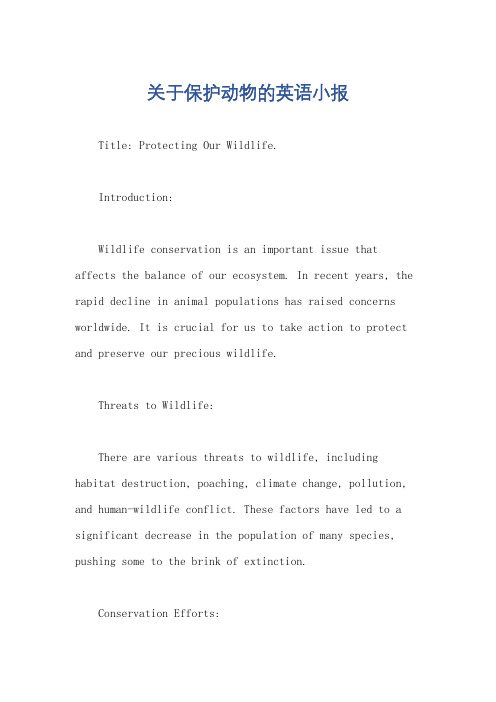
关于保护动物的英语小报Title: Protecting Our Wildlife.Introduction:Wildlife conservation is an important issue that affects the balance of our ecosystem. In recent years, the rapid decline in animal populations has raised concerns worldwide. It is crucial for us to take action to protect and preserve our precious wildlife.Threats to Wildlife:There are various threats to wildlife, including habitat destruction, poaching, climate change, pollution, and human-wildlife conflict. These factors have led to a significant decrease in the population of many species, pushing some to the brink of extinction.Conservation Efforts:Many organizations and individuals are workingtirelessly to protect and conserve wildlife. Conservation efforts include the establishment of protected areas, breeding programs for endangered species, education and awareness campaigns, and the implementation of laws and regulations to prevent illegal hunting and trade of wildlife.Role of Individuals:As individuals, we can also contribute to wildlife conservation. Simple actions such as reducing our carbon footprint, supporting sustainable and ethical tourism, and avoiding the purchase of products made from endangered species can make a difference. Additionally, supporting and volunteering for conservation organizations can have a positive impact.Success Stories:There have been successful conservation stories whereconcerted efforts have led to the recovery of endangered species. For example, the conservation efforts for thegiant panda in China have resulted in an increase in their population. These success stories serve as inspiration and proof that conservation efforts can yield positive results.Challenges and Future Outlook:Despite the progress, there are still challenges in wildlife conservation. The growing human population, urbanization, and unsustainable development continue to pose threats to wildlife. Looking ahead, it is essential to continue and strengthen conservation efforts, promote sustainable practices, and foster a sense of responsibility towards wildlife among future generations.Conclusion:In conclusion, protecting our wildlife is a shared responsibility that requires collective action. By raising awareness, supporting conservation initiatives, and making conscious choices in our daily lives, we can contribute tothe preservation of our diverse and beautiful wildlife for generations to come. Let us all work together to ensure a sustainable future for both humans and animals.。
保护动物英语作文七年级
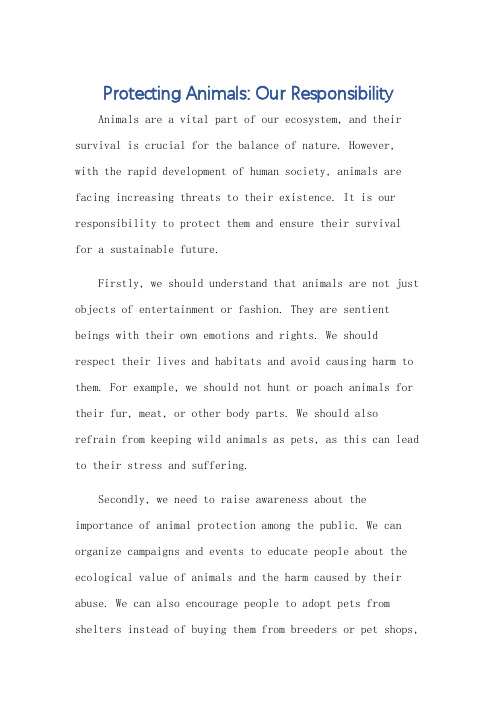
Protecting Animals: Our ResponsibilityAnimals are a vital part of our ecosystem, and their survival is crucial for the balance of nature. However, with the rapid development of human society, animals are facing increasing threats to their existence. It is our responsibility to protect them and ensure their survivalfor a sustainable future.Firstly, we should understand that animals are not just objects of entertainment or fashion. They are sentient beings with their own emotions and rights. We should respect their lives and habitats and avoid causing harm to them. For example, we should not hunt or poach animals for their fur, meat, or other body parts. We should alsorefrain from keeping wild animals as pets, as this can lead to their stress and suffering.Secondly, we need to raise awareness about the importance of animal protection among the public. We can organize campaigns and events to educate people about the ecological value of animals and the harm caused by their abuse. We can also encourage people to adopt pets from shelters instead of buying them from breeders or pet shops,as this reduces the demand for animals and prevents them from being bred in poor conditions.Moreover, we should support policies and laws that protect animals. Governments should enforce strict laws against poaching, hunting, and trading in endangered species. They should also provide funds for theconservation of habitats and the protection of endangered species. We can also contribute to these efforts by volunteering in animal shelters or conservation projects.In addition, we can adopt eco-friendly practices in our daily lives to reduce the harm caused to animals. For example, we can reduce our meat consumption, as meat production often involves the cruel treatment of animals. We can also choose to buy products that are not tested on animals, such as cosmetics and household products.In conclusion, protecting animals is our responsibility. We should respect their lives, raise awareness, support policies and laws, and adopt eco-friendly practices to ensure their survival. Only by doing so can we create a harmonious and sustainable world for ourselves and future generations.**保护动物:我们的责任**动物是我们生态系统的重要组成部分,它们的生存对于自然平衡至关重要。
七下保护动物英语范文
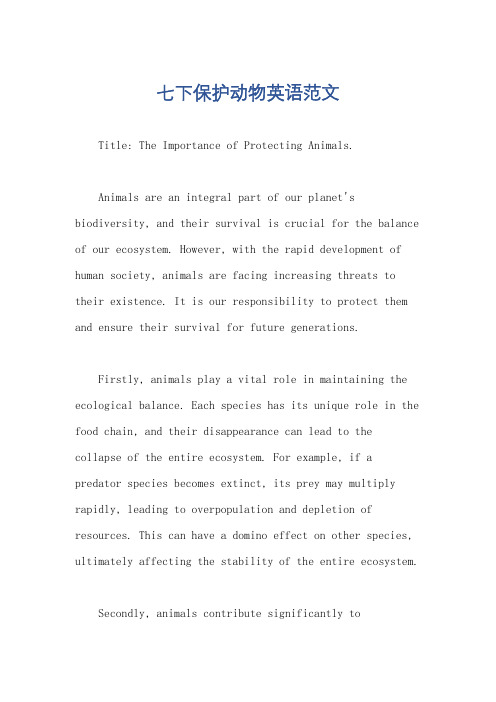
七下保护动物英语范文Title: The Importance of Protecting Animals.Animals are an integral part of our planet's biodiversity, and their survival is crucial for the balance of our ecosystem. However, with the rapid development of human society, animals are facing increasing threats to their existence. It is our responsibility to protect them and ensure their survival for future generations.Firstly, animals play a vital role in maintaining the ecological balance. Each species has its unique role in the food chain, and their disappearance can lead to the collapse of the entire ecosystem. For example, if a predator species becomes extinct, its prey may multiply rapidly, leading to overpopulation and depletion of resources. This can have a domino effect on other species, ultimately affecting the stability of the entire ecosystem.Secondly, animals contribute significantly toscientific research. Scientists study animals to understand their behavior, ecology, and physiology. These studies not only help us understand the natural world better but also provide valuable insights into human health and disease. For instance, research on animals has led to the development of numerous medical treatments and technologies that have saved countless human lives.Moreover, animals have a profound impact on ourcultural and spiritual lives. They have been a source of inspiration for art, literature, and religion throughout history. The bond between humans and animals is deep and meaningful, and it is essential for our mental and emotional well-being.However, the current situation is alarming. Habitat loss, climate change, pollution, and overexploitation are among the primary threats to animal survival. Human activities have destroyed vast tracts of natural habitats, forcing animals to live in increasingly crowded and unsafe spaces. Climate change is affecting animal habitats, leading to changes in their distribution and behavior.Pollution is poisoning their habitats and affecting their health. Overexploitation for commercial purposes has led to the extinction of many species.To address these issues, we need to take immediate action. Firstly, we should conserve and protect natural habitats by limiting urban sprawl and promoting sustainable development. We should also encourage the restoration of damaged habitats to provide safe havens for animals. Secondly, we need to reduce our carbon emissions and adopt renewable energy sources to mitigate the effects of climate change. Thirdly, we should promote awareness and education about the importance of animal protection among the public. By raising awareness, we can encourage more people to adopt eco-friendly practices and support conservation efforts.In addition, governments and international organizations should play a leading role in animal protection. They should formulate and enforce strict laws to protect animals from illegal trade and poaching. They should also fund research and conservation projects to protect endangered species and their habitats.In conclusion, protecting animals is crucial for maintaining the balance of our ecosystem and preserving our cultural and spiritual heritage. It is our responsibility to ensure their survival for future generations. By taking action and promoting awareness, we can create a safer and more harmonious world for all living beings. Let us work together to protect the animals and safeguard our planet's biodiversity.。
英语小报,以保护动物为主题家作文
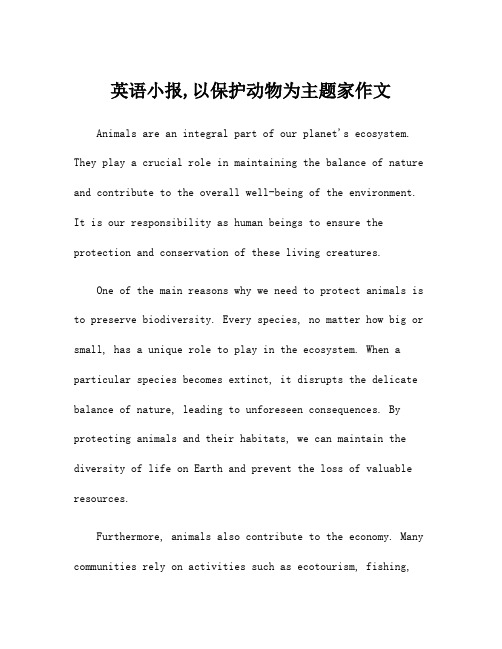
英语小报,以保护动物为主题家作文Animals are an integral part of our planet's ecosystem. They play a crucial role in maintaining the balance of nature and contribute to the overall well-being of the environment. It is our responsibility as human beings to ensure the protection and conservation of these living creatures.One of the main reasons why we need to protect animals is to preserve biodiversity. Every species, no matter how big or small, has a unique role to play in the ecosystem. When a particular species becomes extinct, it disrupts the delicate balance of nature, leading to unforeseen consequences. By protecting animals and their habitats, we can maintain the diversity of life on Earth and prevent the loss of valuable resources.Furthermore, animals also contribute to the economy. Many communities rely on activities such as ecotourism, fishing,and agriculture for their livelihoods. The decline of animal populations can have a significant impact on these industries, leading to economic instability and hardship for local communities.Additionally, animals provide numerous benefits to human beings. For instance, they help in controlling pests, pollinating plants, and dispersing seeds. They alsocontribute to medical research that benefits both human and animal health. By protecting animals, we are alsosafeguarding these essential services that they provide to us.However, despite the importance of protecting animals, many species are facing numerous threats. Human activities such as deforestation, illegal poaching, pollution, andclimate change are causing irreparable harm to animal populations. If these issues are not addressed, many species will continue to decline and face the risk of extinction.To address these challenges, it is essential to take action at both individual and collective levels. Governments, conservation organizations, and communities need to work together to implement policies and practices that protect animals and their habitats. This may involve creating protected areas, enforcing wildlife laws, and promoting sustainable practices in industries such as agriculture and fishing.At the individual level, everyone can contribute to the protection of animals by making simple lifestyle changes. This includes reducing plastic use, supporting sustainable products, and advocating for animal rights. By raising awareness and educating others about the importance of protecting animals, individuals can make a significant difference in the fight against animal extinction.In conclusion, protecting animals is vital for the well-being of our planet and all its inhabitants. It is our moralobligation to ensure the conservation of animal species and their habitats. By taking action to address the threats facing animals, we can create a more sustainable and harmonious world for future generations to enjoy. Let us all work together to protect and preserve the incredible diversity of life on Earth.。
保护动物英文海报作文初中
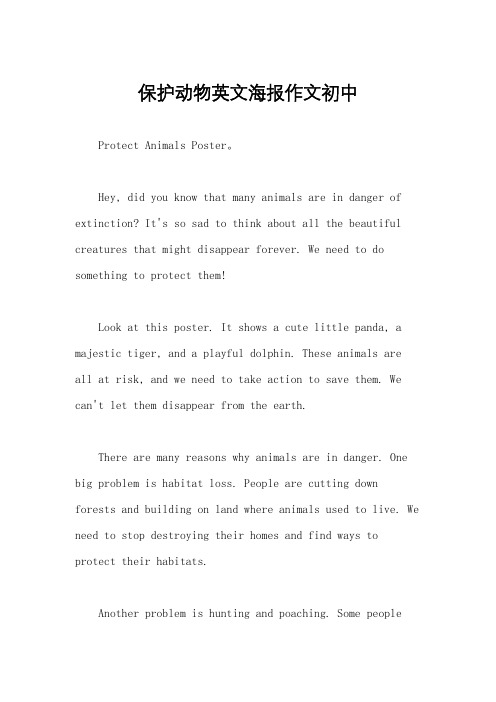
保护动物英文海报作文初中Protect Animals Poster。
Hey, did you know that many animals are in danger of extinction? It's so sad to think about all the beautiful creatures that might disappear forever. We need to do something to protect them!Look at this poster. It shows a cute little panda, a majestic tiger, and a playful dolphin. These animals areall at risk, and we need to take action to save them. We can't let them disappear from the earth.There are many reasons why animals are in danger. One big problem is habitat loss. People are cutting downforests and building on land where animals used to live. We need to stop destroying their homes and find ways to protect their habitats.Another problem is hunting and poaching. Some peoplekill animals for their fur, their tusks, or just for fun.It's terrible to think about these beautiful creatures being hurt or killed for no good reason. We need to stop this cruelty and protect animals from harm.One more thing we can do is to raise awareness. We need to tell people about the importance of protecting animals and the dangers they face. If more people understand the problem, we can work together to find solutions.So, what can you do to help? You can start by learning more about endangered animals and the threats they face. Then, you can spread the word to your friends and family. You can also support organizations that are working to protect animals and their habitats.Remember, every little bit helps. If we all work together, we can make a difference and protect these amazing creatures for future generations. Let's take action and save the animals!。
保护动物英语作文七年级

保护动物英语作文七年级Protecting Animals: A Vital ResponsibilityThe world we live in is a beautiful and diverse place, teeming with a vast array of animal species, each playing a crucial role in the delicate balance of our ecosystem. However, in recent years, we have witnessed a alarming trend of declining animal populations due to various human activities. As responsible stewards of our planet, it is our duty to take action and protect these vulnerable creatures, ensuring their survival for generations to come.One of the most pressing issues facing the animal kingdom is habitat destruction. As human populations continue to grow and urbanization expands, natural habitats are being cleared to make way for development, leaving many animal species without a place to call home. This not only disrupts the natural order of the ecosystem but also threatens the very existence of these creatures. It is our responsibility to find sustainable solutions that balance the needs of both humans and animals, such as preserving and restoring natural habitats, and implementing eco-friendly urban planning.Another significant threat to animal welfare is poaching and illegalwildlife trade. The demand for exotic pets, traditional medicine, and various animal-derived products has fueled a thriving black market, leading to the ruthless hunting and capture of countless animals. This not only decimates populations but also causes immense suffering to the animals themselves. To combat this issue, we must strengthen international cooperation and law enforcement efforts, as well as raise public awareness about the devastating consequences of this illicit trade.In addition to habitat destruction and poaching, animals also face threats from pollution, climate change, and human-wildlife conflicts. Plastic waste, toxic chemicals, and other forms of environmental degradation can have devastating effects on the health and well-being of animals, disrupting their natural habitats and food chains. Climate change, on the other hand, is causing shifts in weather patterns and ecosystem dynamics, forcing many species to adapt or face extinction. Furthermore, the encroachment of human settlements into wildlife areas can lead to conflicts, where animals are often the ones who suffer the consequences.To address these multifaceted challenges, a comprehensive and collaborative approach is required. Governments, conservation organizations, and individual citizens must work together to implement effective policies, fund research, and raise awareness about the importance of animal protection. This includesstrengthening regulations, enhancing law enforcement, and promoting sustainable practices in various industries that impact animal habitats.At the individual level, we can all make a difference by adopting more eco-friendly lifestyles, reducing our consumption of animal-derived products, and supporting organizations that work tirelessly to protect endangered species. Additionally, educating ourselves and our children about the wonders of the natural world and the vital role that animals play in it can inspire future generations to become active stewards of the planet.In conclusion, protecting animals is not just a moral imperative, but a crucial step in safeguarding the delicate balance of our ecosystem. By working together to address the various threats facing the animal kingdom, we can ensure that these remarkable creatures continue to thrive and enrich our world for generations to come. Let us all take responsibility and play our part in preserving the incredible diversity of life that our planet has to offer.。
保护动物的英文范文七年级
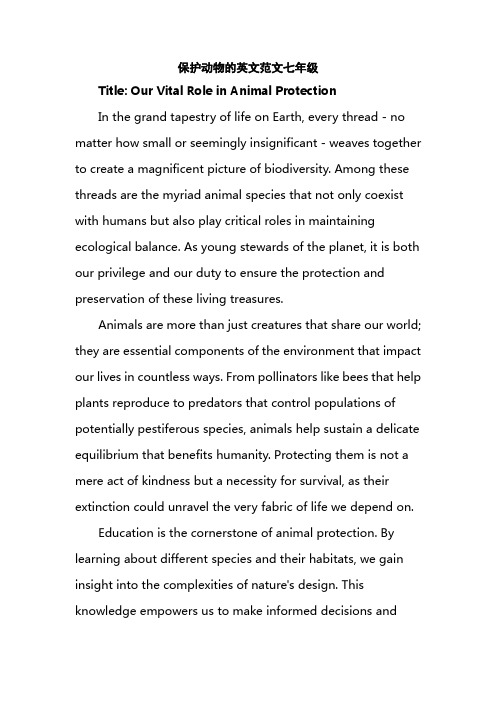
保护动物的英文范文七年级Title: Our Vital Role in Animal ProtectionIn the grand tapestry of life on Earth, every thread - no matter how small or seemingly insignificant - weaves together to create a magnificent picture of biodiversity. Among these threads are the myriad animal species that not only coexist with humans but also play critical roles in maintaining ecological balance. As young stewards of the planet, it is both our privilege and our duty to ensure the protection and preservation of these living treasures.Animals are more than just creatures that share our world; they are essential components of the environment that impact our lives in countless ways. From pollinators like bees that help plants reproduce to predators that control populations of potentially pestiferous species, animals help sustain a delicate equilibrium that benefits humanity. Protecting them is not a mere act of kindness but a necessity for survival, as their extinction could unravel the very fabric of life we depend on.Education is the cornerstone of animal protection. By learning about different species and their habitats, we gain insight into the complexities of nature's design. This knowledge empowers us to make informed decisions andinspire actions that foster coexistence. For instance, understanding the plight of endangered species leads to initiatives like wildlife corridors, which provide safe passage for migrating animals, thus reducing human-wildlife conflict.Advocacy is another powerful tool at our disposal. Through voices united in support of conservation, we can influence policies and practices that safeguard animals against threats such as poaching, habitat loss, and climate change. Communicating the importance of conservation to others raises awareness and expands the network of protectors. We must become the voice for the voiceless, advocating for those who cannot speak for themselves.Action is equally important as words. Participating in local and global conservation efforts, such as beach clean-ups or tree planting, helps maintain environments that animals call home. Simple acts like recycling, reducing plastic use, and choosing sustainable products lighten our ecological footprint, ensuring less harm to the habitats of countless species.Moreover, supporting reputable organizations dedicated to animal welfare and conservation with our time or resources can lead to substantial progress. These groups work tirelessly to rescue injured animals, rehabilitate and release healthyones back into the wild, and campaign against injustices like illegal wildlife trade.In conclusion, protecting animals is an endeavor that demands our collective commitment as students and citizens. It is a task steeped in education, advocacy, and action, guided by the understanding that we do not inherit the earth from our ancestors, but borrow it from our children. The future thrives on the diversity of life we protect today, and it is in our power to ensure that the richness of animal life continues to grace the planet for generations to come. Let us each play our part in this vital mission, for in doing so, we secure a legacy of harmony between humans and the animal kingdom.。
- 1、下载文档前请自行甄别文档内容的完整性,平台不提供额外的编辑、内容补充、找答案等附加服务。
- 2、"仅部分预览"的文档,不可在线预览部分如存在完整性等问题,可反馈申请退款(可完整预览的文档不适用该条件!)。
- 3、如文档侵犯您的权益,请联系客服反馈,我们会尽快为您处理(人工客服工作时间:9:00-18:30)。
初一(5)班马力
Elephant is the largest animal on land today. It weights some
ninety kilograms and is about one meter high when born.
Elephant is usually grey in color, having a long trunk with large
ivory tusks protruding from each side of its mouth.
Otter streamlined body, about 60 to 80 cm,
weight up to 5 kilograms. Head wide and slightly
flat, short kisses, a few root central chin otters to
be short and hard. Eyes slightly prominent,
short, round ears, nostrils, ear canal with water
poured into the valve.
All the rhinoceros basically is short legs, body
stout. Body fat and clumsy, body length of 2.2 ~
4.5 meters, shoulder high 1.2 ~ 2 meters; weight
2800 ~ 3000 kg, thick rough, and into folds are
arranged on the shoulder and waist etc.
Foxes live in forests, grasslands, semi-desert and hills,
living in holes in trees or soil hole, in the evening to go
out foraging, came home until dawn. Because of its
excellent sense of smell and hearing, with agile, they are
able to feed all kinds of mice, rabbits, birds, fish, frogs,
lizards, insects and worms, but also eat a number of
fruit.
Animals have been killed for their fur and feathers, for food, for sport, and simply because they were in the way. We should raise people's awareness to protect animals and our environment. We should not wear or buy the clothes made by animals fur . We should not eat animals. We must take some measures to protect animals effectively.。
